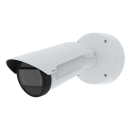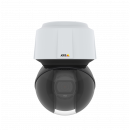
Axis cameras provide real-time traffic info in Croatia.
Key areas of Croatian road infrastructure are monitored by Axis cameras, providing drivers with traffic information via a website and mobile apps.
Mission
Without a doubt, Croatia is a popular tourist destination. In 2017, a record number of 18.5 million tourists visited this Southern European country, many of them by car. The large numbers of seasonal tourists join local drivers each year and put the Croatian road infrastructure under immense pressure. Furthermore, depending on the location, traffic can be affected by various weather conditions, from extreme high temperatures to strong wind and snow. Therefore, the Croatian Automobile Club (HAK) decided to install traffic cameras at key locations throughout the country such as border crossings, toll stations, highway junctions, ferry ports, bridges, and tunnels. The aim was to provide drivers with real-time images of the current traffic situation.
Solution
Initially, the project ran on analog video cameras. The images were then digitized using Axis video servers and sent to the HAK web server periodically. As the technology progressed, a network of Axis cameras replaced the old analog devices. Today, the system is mainly based on Axis cameras monitoring locations with increased threat of heavy traffic or harsh weather conditions. Hence, the requirements were obvious: cameras resistant to extreme weather divergency with reliable performance and possible advance software integration. The Axis camera fleet uses the bullet-type AXIS P1425-LE Mk II and AXIS P1427-LE, fixed box AXIS M1125-E, and AXIS Q6155-E PTZ Network Cameras.
Result
The primary objective of the camera installation has undoubtedly been met: The network of approximately 260 cameras on Croatian roads has increased safety for everyone. With HAK being a national authority on traffic information in Croatia, providing drivers with traffic information is a matter of public interest. The real-time images from the locations surpass other information channels in reliability and impact on drivers, be it in terms of snow conditions, heavy traffic, or other occurrences on the road. Traffic information is available on the HAK website and mobile app to anyone with internet access, and the HAK plans to continuously expand the number of camera locations.
In our project, images must be delivered swiftly to web-servers/webcache, rather than to a central recording unit or a surveillance room videowall, as they primarily end up on our website and mobile apps that are available to the general public. This makes digitizing the image on an IP video server a must for us rather than an option.
The road to IP cameras
The Croatian Automobile Club (HAK) decided years ago to operate a system of traffic cameras in order to provide drivers with real-time images of key Croatian infrastructure areas. “The project was first started in 2004, using exclusively Axis IP video servers to digitize analog video cameras and periodically send still images to our web server. These video server capabilities and API integration are the foundation that the IP-camera software is built on today,” says Goran Baotić, M.Sc., head of the business support division in the HAK. He adds: “In our project, images must be delivered swiftly to web-servers/web-cache, rather than to a central recording unit or a surveillance room videowall, as they primarily end up on our website and mobile apps that are available to the general public. This makes digitizing the image on an IP video server a must for us rather than an option.”

In 2015, the HAK started replacing the old analog traffic cameras with multi-megapixel high definition IP cameras that provide the highest-quality images. “Our modernized system uses Axis IP cameras, mainly bullet-type AXIS P1425-LE Mk II, AXIS P1427-LE, AXIS P1445-LE, AXIS P1447-LE and AXIS P1448-LE, fixed box AXIS M1125-E, and AXIS Q6155-E PTZ Network Cameras,” describes Baotić. The HAK still uses some SD-resolution legacy Axis video servers in places where the digitalization of analog traffic cameras owned by third-party road operators is necessary. “We have experimented with using some other brands of IP cameras, which usually do give decent image quality but disappoint when advanced software integration is necessary,” explains Baotić.
Cameras made for software integration
Ease of software integration is an essential feature for the HAK. The organization relies heavily on Axis VAPIX® API (Application Programming Interface), which is continuously developed. “VAPIX® is unmatched by others, but we also use third-party application packages that run on cameras themselves,” says Goran Baotić. “We also go as far as to enable and use root-level access to the Axis IP-camera Linux SSH shell, which essentially turns the camera into a miniature Linux server. This feature has ‘saved’ us on multiple occasions in terms of giving us access to the rest of LAN in remote and distant locations.”

The cameras are connected to a wired network where available, or, alternatively, wirelessly to a cellular network. The cameras are usually mounted on poles or on top of other tall structures. “The biggest challenge was to mount the cameras in extreme and inaccessible locations, such as ferry ports or bridges, which are usually remote and lack a stable power supply, together with securing a decent and stable network connection,” describes Baotić. Moreover, some camera installations need to withstand gusts of bora – a Croatian northerly wind that can reach speeds above 250 km/h and occurs along the length of Adriatic coast – and other unfavorable weather conditions, such as extreme temperatures, sea salt, corrosion, etc.
Implementing new technologies
The HAK camera system enables Croatian drivers and tourists to see the traffic situation in real-time and thus helps them to make more knowledgeable and relevant decisions before embarking on a journey. This can help greatly in preventing the traffic jams that sometimes occur on Croatian roads when the summer season arrives and thousands of European tourists head south. However, cameras offer a great deal of useful information in winter as well, as most of the Croatian roads are exposed to snowy conditions.

Currently, drivers in Croatia can access the traffic images from about 260 cameras, most of which are Axis, either on the website or via free applications running on Android and iOS devices. The HAK works constantly on developing the system and implementing the latest technologies. “We have recently introduced machine learning features to our project. The aim is to blur-out sensitive personal information in images retrieved from cameras, but this is done in post-processing on the server infrastructure,” describes Baotić. In the future, the goal is to cover more Croatian roads with traffic cameras. Not only do they increase driver comfort and safety, but they can also help with traffic management and road network development. “Our plan is to continuously expand the number of locations covered by traffic cameras, as well as integrate multiple machine learning features in order to better understand traffic patterns,” concludes Baotić.
Products & solutions


